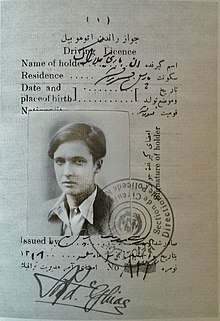Annemarie Schwarzenbach
Her bisexual mother brought her up in a masculine style, and her androgynous image suited the bohemian Berlin society of the time, in which she indulged enthusiastically.Her mother, Renée Schwarzenbach-Wille, the daughter of the Swiss general Ulrich Wille and descended from German aristocracy, was a prominent hostess, Olympic equestrian sportswoman and amateur photographer.A relationship developed, which much to Schwarzenbach's disappointment did not last long (Erika had her eye on another woman: the actress Therese Giehse), although they always remained friends.Tensions with her family increased, as some members sympathised with the far-right Swiss Fronts, which favoured closer ties with Nazi Germany.They lived together for a while in Tehran, but when they fled to an isolated area in the countryside to escape the summer heat, their lonely existence had an adverse effect on Schwarzenbach.She had been interested in the career of Lorenz Saladin, a Swiss mountain-climber and photographer from a modest background who had scaled some of the most difficult peaks in the world.Here she wrote what was to become her most successful book, Lorenz Saladin: Ein Leben für die Berge (A Life for the Mountains), with a preface by Sven Hedin.She also wrote Tod in Persien (Death in Persia), which was not published until 1998, although a reworked version appeared as Das glückliche Tal (The Happy Valley) in 1940.In June 1939, in an effort to combat her drug addiction and escape from the hovering clouds of violence in Europe, she embarked on an overland trip to Afghanistan with the ethnologist Ella Maillart.They set off from Geneva in a small Ford car and travelled via Istanbul, Trabzon, and Tehran, and in Afghanistan took the Northern route from Herat to Kabul.Schwarzenbach, who had plenty of troubles herself, knew that there was no future in a one-sided relationship and avoided meeting with McCullers, but they remained friends.Schwarzenbach was also at this time involved in a difficult relationship with the wife of a wealthy man, Baronessa Margot von Opel, and was still struggling with her feelings for Erika Mann.On 7 September 1942 in the Engadin, she fell from her bicycle and sustained a serious head injury, and following a mistaken diagnosis in the clinic where she was treated, she died on 15 November.During her final illness, her mother permitted neither Claude Clarac, who had rushed to Sils from Tétouan via Marseille,[4]: 223 nor her friends, to visit her in her sick bed.[1] Despite her problems, Schwarzenbach was productive: besides her books, between 1933 and 1942, she produced 365 articles and 50 photo-reports for Swiss, German and some American newspapers and magazines.Schwarzenbach is portrayed by Klaus Mann in two of his novels: as Johanna in Flucht in den Norden (1934) and as the Angel of the Dispossessed in Der Vulkan (The Volcano, 1939).



ZurichSils im Engadin/SeglHorgenUniversity of ZurichAchille-Claude ClaracRenée Schwarzenbach-WilleAlexis SchwarzenbachUlrich WillebohemianThomas MannCarson McCullersReflections in a Golden EyeBocken EstateLake ZurichnovellaKlaus MannTherese GiehseWeimar RepublicWestendRuth LandshoffandrogynousUttingAmmerseeHitlerDie SammlungMarianne BreslauerSwitzerlandTehranmorphineLorenz SaladinSven HedinPersianBelgian CongoAfghanistanElla MaillartIstanbulTrabzonTurkestanThe Journey to KafiristanLisbonFree FrenchMargret BoveriMarcella O'GradyTétouanEngadinSwiss Literary ArchivespsychiatricHarry Ransom CenterUniversity of Texas at AustinAmsterdamSeagull BooksUniversity of Chicago PressJack von Reppert-BismarckNicolas BouvierMaillart, EllaThe New York TimesAnnemarie Clarac-SchwarzenbachHuffPostSwiss National LibraryGerman National LibrarySwiss InstituteNational Library of Israel